All woes are lighter if there’s bread. — Miguel de Cervantes
In the very fine year of 1700, Claude de Pinteville published Le Petit Trésor de Santé, The Little Treasury of Health. Within its pages, one finds the most useful remedies for every ailment, from coughs and fever, headaches and melancholy, to rabies, leprosy, and the plague. He also gives sound advice for preserving one’s health, a “good diet for a good life”. His “excellent remedies to protect one against bad air,” for example, offer a simple solution for both gentlefolk and commoners. “For the rich: Every morning, you must eat a slice of toasted bread, spread with butter, and dusted with “poudre de duc” which is cinnamon and sugar mixed together, to strengthen your brain, heart and stomach. For the poor: One must eat each morning a crust of bread, rubbed well on both sides with garlic, then spread with butter, and eat it first thing in the morning on an empty stomach.”
“The most necessary of all foods, which Divine Goodness has created for the maintenance of man's life, is Bread. His blessing extends so far over this food that we are never disgusted by it, and the most precious Meats cannot be eaten without Bread.” So wrote Nicolas de Bonnefons in 1655 in his influential tome Les Délices de la Compagne, explaining why he opened his book with the chapter on bread.
Bread. The staff of life. C'est à la sueur de ton visage que tu mangeras du pain: By the sweat of your brow that you'll eat your bread. Élie Reclus, in his 1909 treatise Le Pain, quoted Genesis to illustrate his thoughts on bread: “Man toils and toils for his daily bread, walks, runs, and hustles, supporting hard work.” Man, in other words, will do anything to have bread.
Revolutions have been started over the lack of bread. And the scarcity of wheat flour led to innovations in science, technology, and bread making to appease the masses. In the great houses and castles of France, the pastry oven was tucked away in a corner of the kitchen, reserved for the family’s use, but bread ovens were out in the courtyard where anyone from the surrounding villages and farms could come bake their own bread. Bread, the grand families understood, was a necessity for everyone.
I’m not here to recount the long, long history of bread. Bread has always been the most basic staple through many cultures across many centuries, a tradition reaching back to antiquity and evolving alongside agricultural, technological, scientific, and gastronomic developments. What I want to illustrate is just how essential bread is to life—or at the very least, to life in France. In his 1905 Dictionnaire Universel de la Cuisine, Joseph Favre claimed that the French word for bread, pain, comes from the Latin panis, itself derived from the Sanskrit pâ, meaning “to nourish.” The idea of bread as nourishment has remained steady throughout France’s history. “La nourriture des forts, du pain qui donne la santé de l’âme,” wrote Madame Dufrénoy in her 1816 book La Petite Ménagère, or The Little Housewife, referring to bread as “food for the strong, bread for the healthy soul.” As de Pinteville made clear, one should start every day with bread, and very little else was needed.
“Bread is the first, most universal and essential food,” wrote César Gardeton in his 1826 Dictionnaire des Alimens (sic), Dictionary of Foods. “Bread, toasted and sprinkled with oil and sugar is good for soothing excessive hunger caused by the cold. Toast with wine and sugar fortifies the stomach.” Published in 1688, Armand Jean du Plessis duc de Richelieu wrote: “When a place is under siege, bread (to feed the troops) is almost more important than powder.”
“What it (bread) is for me: the food par excellence!” The October 13, 1923 issue of the weekly Religious Bulletin of the Archdiocese of Rouen was devoted to the topic of bread, an excerpt of the book Le Pain de Vie, The Bread of Life, by Etienne Jos. “Scholars will tell me it's not the most nutritious, my senses will find more delicious; but as long as there have been men on earth, and who eat, bread has always been both the daily food of the rich and the poor and the symbolic expression of all food, that of the body and that of the spirit.”
Bread was the food that nourished both body and soul.
“Food is simple, or medicinal; the simple nourishes and restores the parts (of the body) and maintains them in the same state; as, for example, bread.” It was a rare thing that Louis Lémery included a prepared food in his book Traité des Aliments (Treatise on Foods) in 1705, a pioneering work in the field of dietary science and nutrition. He described every possible foodstuff, individual ingredients, fruits, meats, herbs, spices, vegetables, and how each affects the body, the health benefits and dangers, and the medicinal properties of each single aliment, but nothing prepared. Except bread. He obviously saw bread as an important foodstuff, one central to man’s diet, one of our most commonly consumed foods. “Bread,” he wrote, “is very nourishing and provides a wholesome food. The crust of roasted bread tightens and its crumb used as a poultice softens, it digests, soothes and resolves. Bread only produces bad effects when used excessively, or when poorly made. Bread is suitable for all times, ages, and temperaments.”
Bread had long been considered the most basic and elemental foodstuff, enduring across ages no matter what other foods were in fashion or consumed at the time, no matter the shifting abundance or availability of other provisions. In 1564, MM. Charles Estienne and Jean Liébault wrote L'Agriculture et Maison Rustique (Rustic House, or, The Countrey Farme) and confirmed: “It is certain that bread holds the first rank among the things which feed Man.....Bread alone never displeases, in health or sickness, it is the last appetite lost, and the first regained in illness; in health, it is the first and last eaten, pleasant and agreeable in all types of meals. Bread, by a surprising blessing of nature, is endowed with all the flavors that particularly entice and attract any food to be eaten. Bread, by its goodness, corrects the vices (bad flavor or unhealthy qualities) of other meats (foods) and helps their virtues, which is why the common proverb says that all meat is found good and profitable (to health) when accompanied by bread. Also we observe daily,” he concludes dramatically, “that most of those who eat their meats without bread always have stinking breath.”
Bread was a subject of keen interest among scientists and medical men, particularly in understanding what made a loaf truly good for the body—whether it was the type of flour used, the method of baking, or even the timing of its consumption. While Estienne and Liébault remarked: “The only drawback of bread on one’s health is due not to the mediocre qualities of bread but to its excessive use,” many others saw fit to dig deeper into the topic. They spoke with great confidence—firm in their judgments, and seldom troubled by doubt. As Lémery, physician, chemist, and botanist wrote: “Bread only produces bad effects when used excessively, or when poorly made.” Or, as Anselme Jourdain and Jean Goulin wrote in their 1771 Le Médecin des Dames, The Ladies’ Physician or the art of preserving a woman’s health, "Everyone uses bread. When it's well made, and when you're careful not to eat it hot, you are rarely troubled. It's one of the lightest foods, and one of the least overindulged in.” That last observation might very well be disputed, but…
“Of all foods, bread is the most useful: we eat it with all kinds of meat and vegetables; without it, the best dish becomes insipid.” Pierre-Joseph Buc’hoz—physician, lawyer, and naturalist—opened his 1787 book L'Art de Préparer les Alimens, Suivant les Différens Peuples de la Terre (The Art of Preparing Foods, According to the Different Peoples of the Earth) by turning his attention to bread, not even waiting for the first chapter but launching into the topic in his lengthy preface. “It serves as food for rich and poor alike; it is the basis of all meals and the ornament of tables; it is a food of prime necessity…” And then he dives right into “its goodness depends on the way it is prepared and cooked. The lighter and more porous the bread, the better it is. The bread must be sufficiently leavened without being too leavened, and it must be properly baked. The day's bread is often preferred to the previous day's; it's softer and more pleasant, but on the other hand it's harder on the stomach and less nourishing.”
“Nothing is more common than to see villagers in the countryside feeding on coarse bread made of rye, barley and oats, and yet enjoying a peaceful rest and even sleeping under the stars without a pillow; whereas the rich, satiated with the most exquisite foods, often find it hard to enjoy a quarter of an hour's rest on their soft, delicate beds.” Who ate which bread made with what flours was a serious subject of commentary, rather interesting considering they were all fairly well-to-do upperclass learned men. “Bread made from whole-wheat flour is suitable for ploughmen, gravediggers, porters, and other people who do perpetual work,” wrote Estienne and Liébault. “Bread made from fine flour is good for idle people who don't do much physical work, such as students, monks, canons, and others who need easily digestible food. Bread made from rye flour is very black, heavy, doughy with a sticky texture, and difficult to digest, but suitable for eating by villagers, not the great Lords and the well-to-do. Soft bread, otherwise known as pain de bouche, is for the great Lords; biscuits (hard bread), made from wheat flour, is for those who are on special diets; biscuits (hard bread) made from rye and other lesser kinds of wheat, is for bargemen and mariners and those who lay siege to towns.”
One’s bread, evidently, ought to suit one’s rank. You are what you eat, I guess.
And yet, there were those who found the idea of “separation of class and bread” less than satisfying. In fact, there were those that thought everyone should be eating those coarser, browner breads.
“(Bread is) the perfect food for restoring depleted strength,” wrote Aloïs Burger in 1884. His book Le Pain: Question Alimentaire was a long lamentation on the gradual abandon of home-baked brown bread for white baker's bread in French households. He finds the bread made at a boulangerie to be less healthy, less appealing, either too tender and soft (which his own stomach couldn’t properly digest) or stale (which he personally found tasteless). He therefore found himself neglecting his meals (which were worthless without this tasty, nutritional base) and became sickly. He bemoans the widespread abandonment of homemade bread, always wholesome brown, in favor of white, refined loaves from local bakers, which the population, he found, relied on more and more—a shift he believed contributed to the 'constitutional decline' of the population.
The women of Lyon, to be beautiful and to have a beautiful complexion, a solid and plump, luscious body, use no other bread than rye; those who are very fond of drinking, instead of herbal tea, cider, beer, or any other beverage, can drink breaded water, rye bread well beaten in water. - Estienne and Liébault
“Bread is such a necessary food that we can't do without it.” states Lémery. “We eat almost nothing without bread…When you have bread, you can do without any other food.” Well, not quite, but you get his point. “We eat almost nothing without bread, and even without it most meats would give us a disgust that would make us hate them in no time.” The French and their bread….
In a French household, bread is always on the table—morning, noon, evening, and in between—eaten with every meal and snack. By the Middle Ages, bread was not just a food, it was a necessary and much-used ingredient in the kitchen. Bread was used for breadcrumbs - sometimes ground with spices - and puddings - and French toast, to thicken sauces and soups, to bind quenelles, stuffings, and fillings. At this time, bread was also used as a plate, called a “trencher”; the food was placed on thick slices of stale bread which not only held the food but absorbed sauces, which soften the bread while flavoring it. At the end of the meal, the bread could be eaten by the diner, tossed to the dogs, or given to either a servant or the poor. Today, bread is served plain, without butter, in most French homes and restaurants alike: just bread, used to push food onto a fork, to accompany bites of cheese, and to mop up sauces, most likely an echo of the medieval “trencher” - old habits die hard. Bakeries are everywhere. In my small town alone, there are eight boulangeries—not counting the ones inside the three local supermarkets—for a population of just 8,000. There are even a couple of vending machines that dispense freshly baked baguettes: drop in a few coins, like you would for a soda or a bag of chips, and out comes a warm loaf, allowing the locals to have bread even when all the boulangeries are closed.
“If, in a word, we wanted to define a people by its essential food, we could say that the French eat a lot of bread.” So declared The French Women’s Union magazine in its November 22, 1952 issue, offering choice words and a selection of recipes. After years of wartime scarcity and bread rationing—evident throughout the previous decade of their publication—French women could at last breathe easy and serve their families the bread they needed. Nanette, the magazine’s columnist, left no doubt about the central place of bread in French life. Italians have their pasta, she explained, the Germans their potatoes, others their rice, couscous, or oat porridge—every culture has its foundational food. “To understand the French, one only has to look in the window of any Parisian bakery and see the astounding array of breads. In no other country in the world, will one find such a variety of breads.”
Simply kneaded, flour makes bread - the staple diet of the peoples of the ancient world - yet when employed by skilled hands, it can be used in all the most delicate combinations dreamt up by the most refined culinary arts. - Le Chocolat, by Delafontaine et Dettwiller 1859
Bread is a food with a multitude of uses, fresh, yes, but stale, as well. In a French household, bread is never lost, thrown away, or wasted—just as it has been since the Middle Ages, when every loaf, every slice, every crumb was a valued resource. Bread has the magical powers of transformation, reappearing as French toast (pain perdu, in French, “lost bread” which of course is never lost), bread pudding, stuffing, breadcrumbs, as a binder, croutons for soup or salad, sandwiches and tartines (open-faced, much like crostini or bruschetta). That extraordinary versatility is an important factor in any food we buy or make these days.
Our baker arrived from Paris; soon, the prince’s table was served with French-style bread, and everyone was happy. - Marie-Antoine Carême, Le Pâtissier Royal Parisien, 1815
I recently wrote a piece on bread for The Contrarian Substack and found the subject so interesting that I decided to expand on it for my own. You can find the recipe for my favorite homemade “French” bread on that post - it is a recipe easy enough for the most inexperienced, novice bread bakers while being an extraordinarily delicious loaf (or 3).
What to do with leftover bread? The French never throw bread out, if they can help it. Bread pudding, croutons large or small, a good croque-monsieur, or even tossed to the chickens (my employees do that with the leftover brioche from the hotel breakfast) or the cows. While researching the topic, I discovered another use for bread - a soufflé. This is not a bread pudding, but rather a real soufflé. The bread acts as a thickener like the more traditional roux - butter, flour, and milk cooked together - or pastry cream, either of which is the normal base for a soufflé. Using a good, bakery-quality pain de mie or brioche also adds a slight flavor and sweetness.
This recipe is my first try at a soufflé au pain, based on a recipe from La Pâtisserie de Marie-Claire by Jeanne Grillet, 1948, and while I want to adjust it, adjust both the ingredients and the method of putting the ingredients together, it was too good not to share. I’ll be posting every other developed and tested version of this old, forgotten dessert.
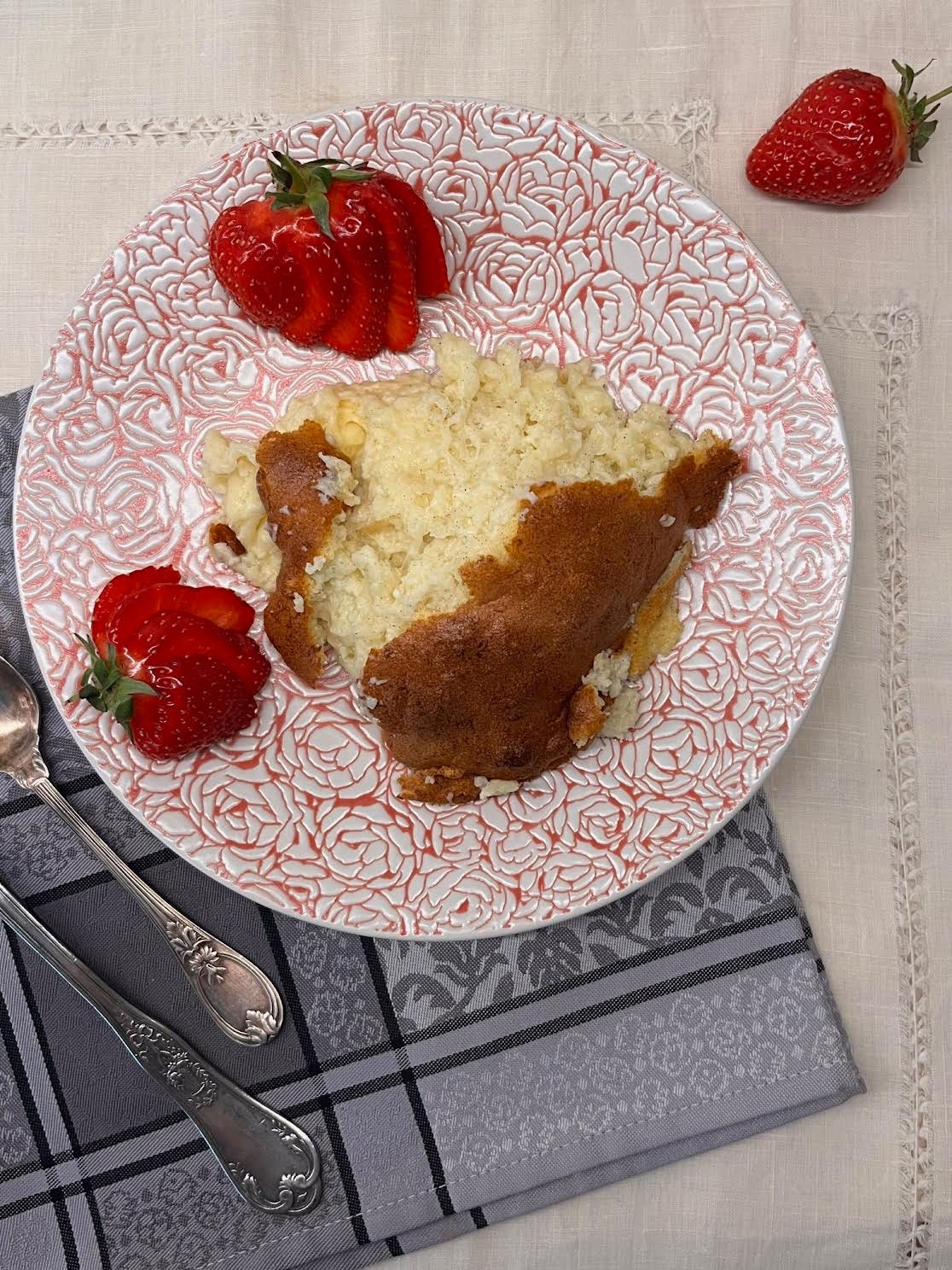
Soufflé au Pain - Bread Soufflé
This soufflé is both light and custardy; its smooth, creamy texture is luxurious - the first and only word that came to mind when I put the first warm spoonfuls into my mouth. This is a dessert that popped up occasionally in old 19th and early 20th century French cookbooks and it intrigued me enough to want to try it.
8.8 ounces or slightly more than ½ pound (250 grams) pain de mie (a good bakery-quality white bread) or brioche with the crusts removed - the cubes will fill a 4-cup/1 litre glass measuring cup
3 cups (¾ liter or 700 ml) milk
1 vanilla bean, split lengthwise, seeds scraped and reserved to use, or 1 teaspoon vanilla extract
60 grams butter, softened
½ cup (100 grams) sugar
6 eggs, separated (* see note)
Note: eggs are easier to separate when chilled but the whites beat up higher and stiffer when closer to room temperature. I always separate my eggs cold, putting the yolks in one bowl, the whites in a large plastic bowl large enough to beat them high, then allow them to come almost to room temperature. I add a small pinch salt and just 2 drops fresh lemon juice to the whites to help stabilize them when beating (this acts like cream of tartar).
Preheat the oven to 400°F (200°C). Butter a 2-quart (8-cup) - 2 liter soufflé dish. Dust the bottom and sides with a small amount of sugar.
Remove the crusts from the bread; cube the bread.
Place the milk in a large saucepan with both the split vanilla bean and the scraped seeds; gently warm the milk over a medium-low heat. Add the cubed bread to the warming milk and, using the back of a slotted spoon or a large table- or serving-spoon, press the cubes under the surface until the bread is completely drenched in the milk and beginning to soak up the milk and soften.
Stir or whisk in the butter dropped into the warming milk in small pieces. Stir in the sugar.
As the milk continues to heat, keep pressing and stirring - even whisking gently - the bread until the cubes are soft and dissolving (you want the bread to be completely dissolved in the milk although mine never quite did completely).
Remove the saucepan from the heat before the milk comes to the boil. Continue to stir or whisk the bread until the milk has cooled at least to tepid. Remove the split vanilla bean.
Place the egg yolks into the largest mixing bowl you own. Slowly whisk in the milk/bread liquid until the mixture is completely blended and as smooth as possible. Don’t worry if you still have bits of bread floating around; these will melt into the soufflé as it bakes.
Using very clean beaters, begin beating the egg whites on low speed for 30 seconds then gradually increase the speed to high. Keep beating the whites until they are thick and stiff peaks hold when the beaters are lifted out.
Now the hard part. There is so much liquid that it is difficult to “fold in” the beaten egg whites. Stir as much in as you can - after “folding” about a third of the whites into the liquid, I began pouring the liquid little by little into the beaten whites and folding them together this way, eventually pouring it all back into the rest of the liquid batter. Do as much and as well as you can without deflating the whites. Pour into the prepared soufflé dish.
When I poured the (liquid) batter into the prepared soufflé dish, there were still bits of bread and small lumps of whites in it, but magically, these all disappeared in the baking, leaving a really smooth and creamy texture - with a custardy bottom - to the soufflé. Just do your best.
Place the filled soufflé dish into the preheated oven and lower the oven temperature slightly to 375°F (190°C) and allow the soufflé to bake for an hour.
Remove from the oven and serve immediately. This is delicious on its own or served with fresh summer fruit and very lightly sweetened whipped cream or a drizzle of chocolate sauce.

Thank you for reading and subscribing to my Substack Life’s a Feast. Please leave a comment, like and share the post…these are all simple ways you can support my writing and help build this very cool community. If you would like to further support my work and recipes, please consider becoming a paid subscriber.
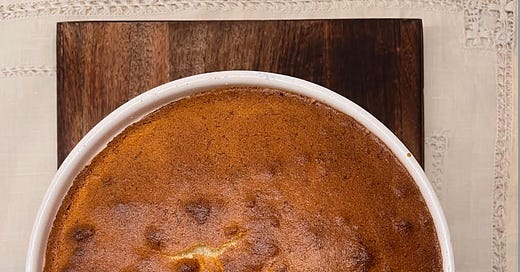





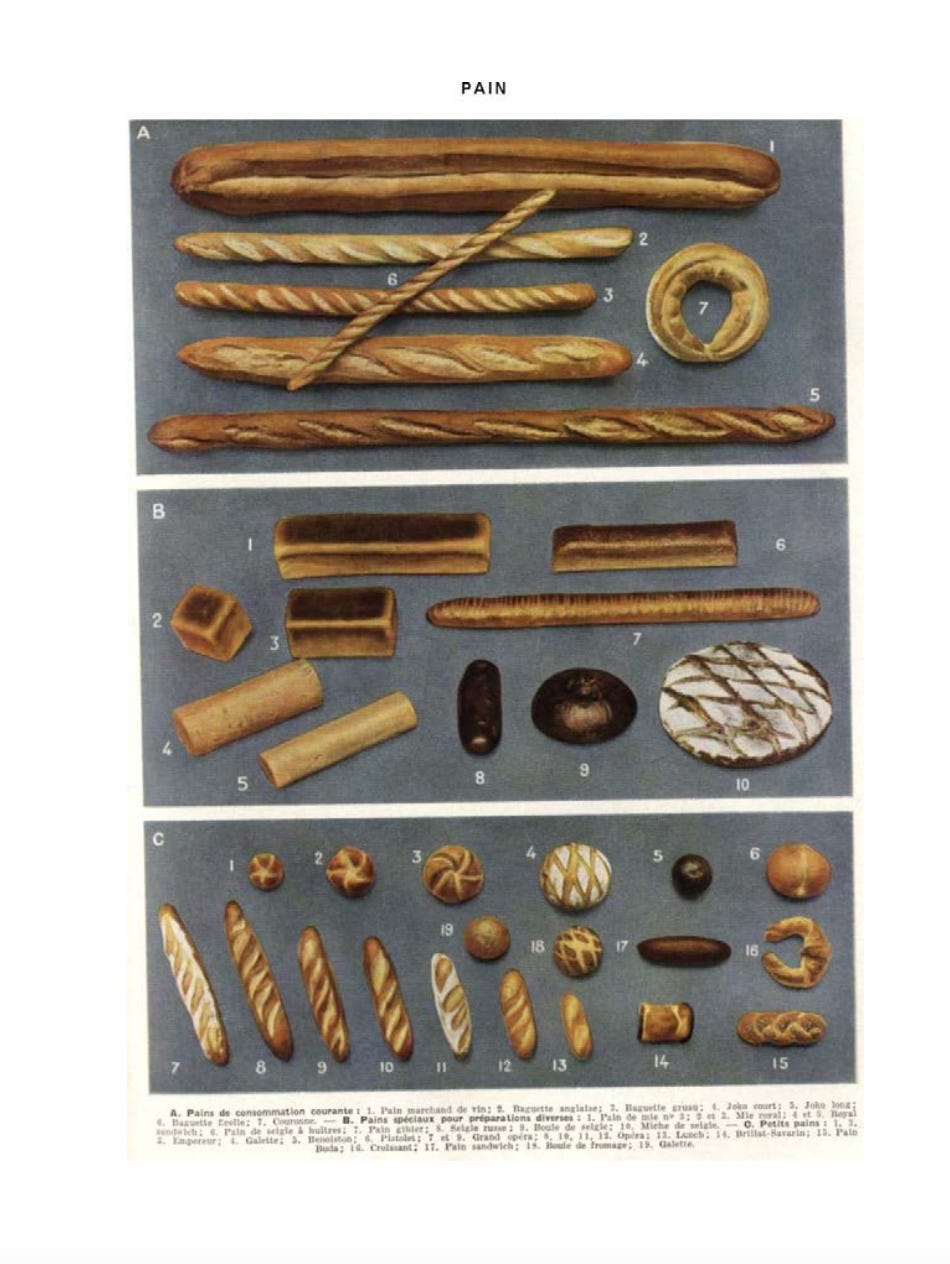
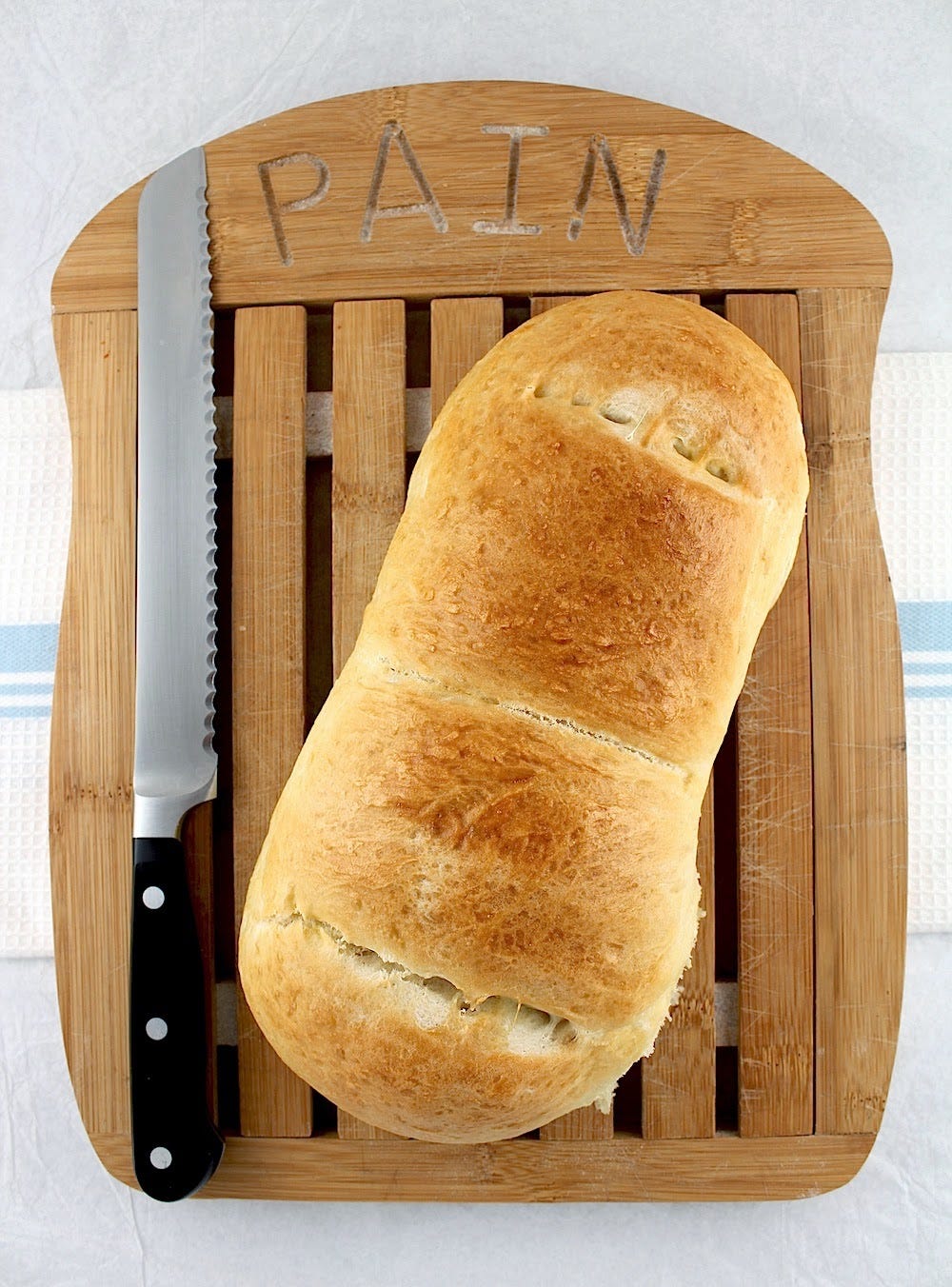

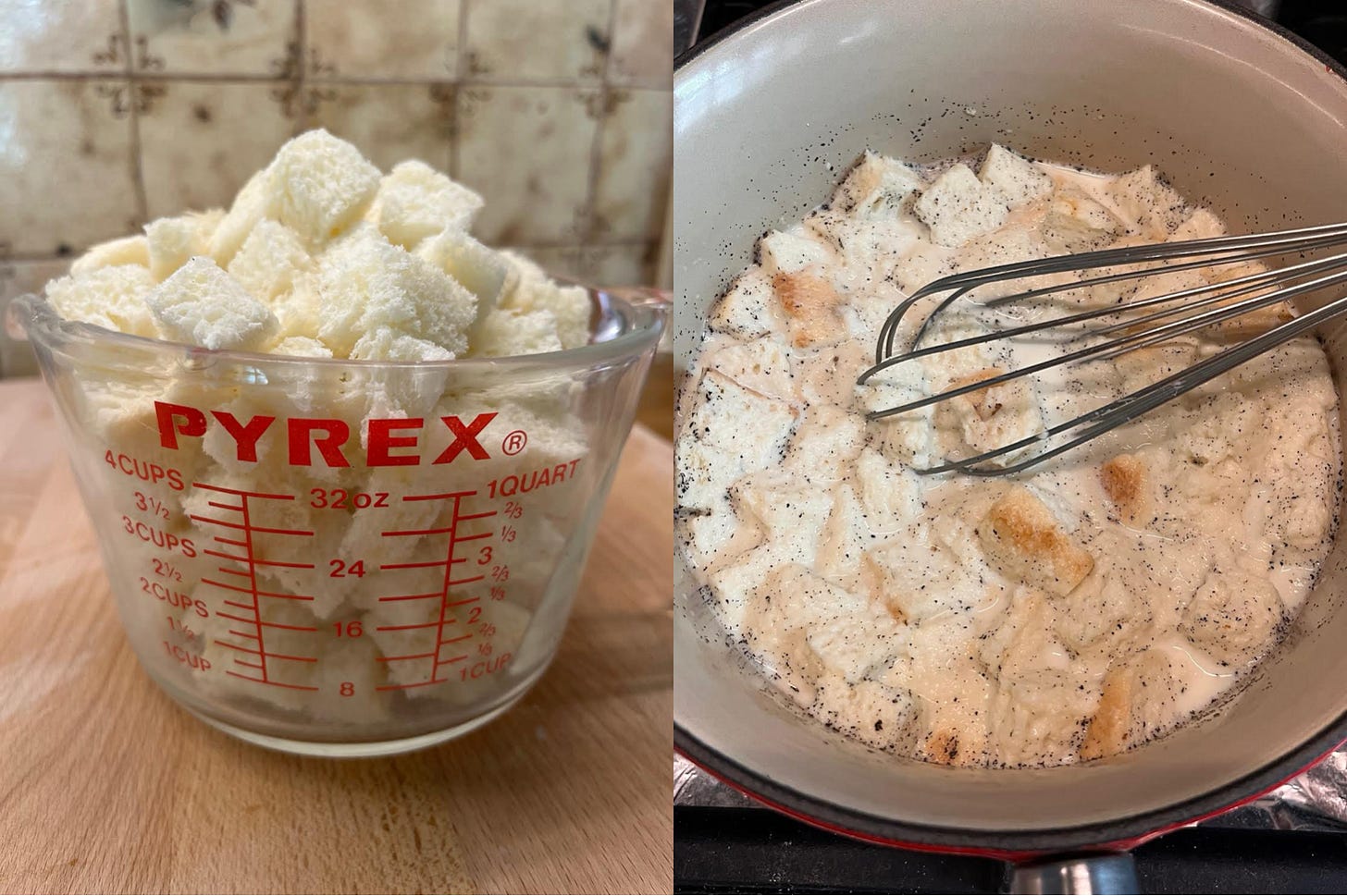
Bread! I am always fascinated with its history within cultures. It's pure magic. Thank you for this lovely article delving into its French roots.
Absolutely wonderful article, Jamie! Loved Pierre-Joseph Buc’hoz‘s alignment of class with bread types. And the soufflé recipe looks fabulous. 🙂